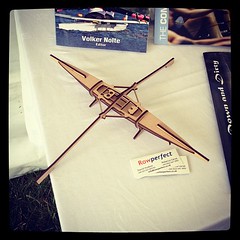Buying your own equipment is a great step forward in any rower’s athletic career. Ask any long term athlete about their first boat or their first pair of oars – we all remember them. Mine was a wooden shell made by a Putney boatbuilder and it had little brass nails holding the struts onto the hull.
 Model single scull from @rowperfect (Photo credit: rebeccacaroe2000)
Model single scull from @rowperfect (Photo credit: rebeccacaroe2000)
Wish I’d kept the wooden sculls though – I always blamed the boatman at Marlow for ‘losing them’ in a boathouse clean out!
Buying oars and sculls
There are three important things to consider when buying second hand oars and sculls:
- Design
- Price
- Wear
Design is all about the blade shape and the construction of the shaft and handle. There are quite a few variations from over recent years so for example Crokers from the early 2000s had a reputation of the sleeve not being square on the shaft while Concept 2 and Dreher sculls tended to delaminate the tip of the carbon blade. This C2 solved with the ‘vortex edge’ glued over the tip. Check the exact age and design of the pair you are considering.
Price for sculls new are up to £600 per pair – a second hand pair can be £200 – 300. The range depends on how much they have been used – the more use, the lower the price.
Wear – take a look at the handle, sleeve and button and the spoon. Wear shows up wherever the scull is in contact with another surface (your hand, the oarlock and the pontoon / water). The handle and grip can become perished; sometimes the handle is shaved down if it’s a wooden oar – is the circumference appropriate for your hand size?
The oarlock rubs every time the oar is squared and feathered. Run your finger over the sleeve and feel the smoothness and whether it’s flat on the back plate or rubbed into a groove. Sleeves can be replaced (all the manufacturers offer replacement services) but it costs and you should build this into the calculation on price.
The oar tip and the back of the spoon are where you will see signs of use – every time the oar scrapes along the pontoon dock when you land will take paint off the back and then begin to dig into the carbon. Most oars have carbon on the outside and “syntactic foam” on the inside in a sandwich construction. Look for places where the carbon is split and run your hand over the edges and along the back to see if the surface is smooth. Lower the price if the wear is noticeable.
Try out the oars yourself
Take them for an outing – when you row try to see if the oars are stiff; is the pitch accurate (don’t dive or wash out at the finish) and how quickly they engage with the water. Remember to first set them to the same length and inboard that you’re used to so the comparison is as fair as possible. If you can try them in your own boat, even better.
On the land afterwards, take a pitch gauge and check the pitch (angle) on the oars or sculls. See that they are the same on bow and stroke side. Again, it’s not a deal breaker if they aren’t but you can negotiate down on the price.
Buying Second Hand Rowing Gear
Here’s a straightforward guide to buying equipment for your rowing club, Buy it Right by Mike Davenport. Mike knows how to select and what to look for in boats and other equipment. A great guide book for every club committee or individual who wants to invest in the right boat or oars.







